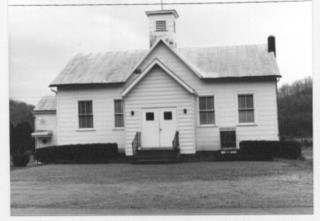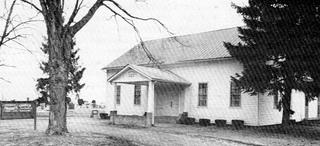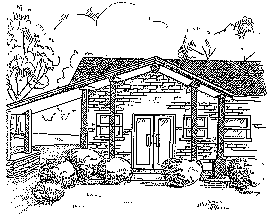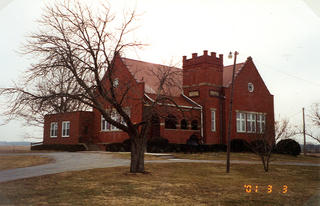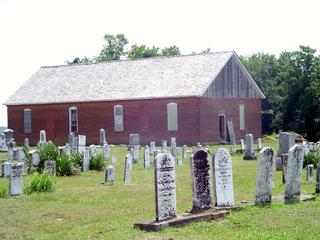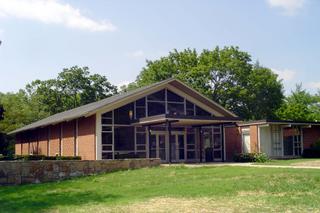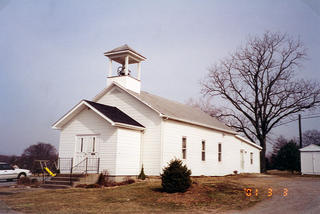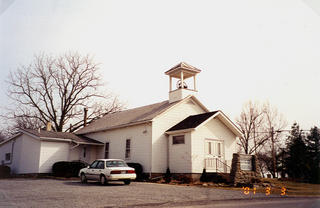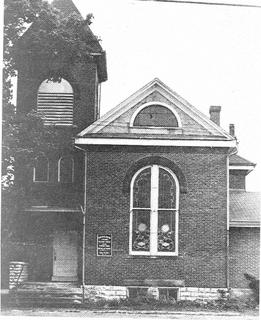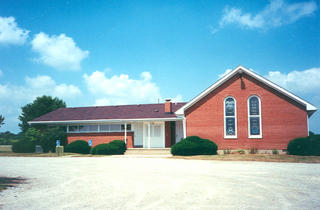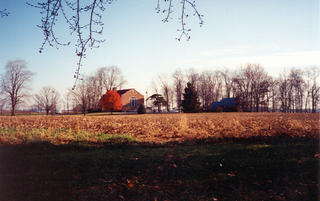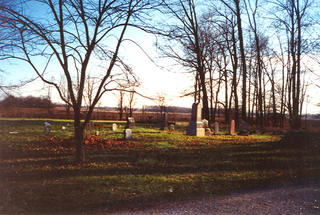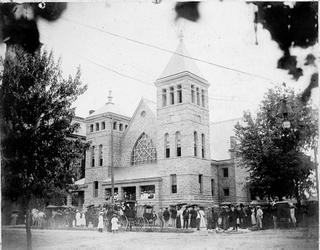Lydia Ann Conard Chandler ~ The First Matron of the Friends Boarding Home in Waynesville
Lydia was also a dedicated member of The Order of the Eastern Star. Lydia Conard (before her marriage to A. B.) affiliated with Miami Chapter #107, Order of the Eastern Star in Waynesville on June 11, 1906. The Miami-Gazette reported on June 13, 1906:
". . . After the regular routine of business had been disposed of, Miss Lydia Conard, Matron of the Friends Home, was given a cordial welcome into the local lodge being admitted from a Toledo organization, after which light refreshments were served."
She was an active member. On December 10, 1906 she was installed as Chaplain of Miami Chapter. In 1908 she served on many investigating committees. On December 14th, 1908, now as Lydia Chandler, she was installed as Warder. The following are more examples of her activity. The Miami-Gazette reported on December 3, 1913:
"INSTALLED OFFICERS: Messrs and Mesdames J. E. Janney, J. C. Hawke and C. M. Robitzer and Mesdames A. B. Chandler, F. H. Farr and Maybelle Fitzgerald motored to New Burlington and attended the installation of officers for a new chapter of the Order of the Eastern Star at that place Tuesday evening. Mrs. Hawke acted as installing officer. After the work, a sumptuous banquet was served. All report a splendid time."
In the February 11, 1918 Minutes of Miami Chapter #107 is found the following entry: "Sister Lydia Chandler asked for her demit as she can not attend here any more and wishes to join at New Vienna (#327)." Lydia was received into the New Vienna Chapter #327 on April 5, 1918. The night before her funeral an Order of the Eastern Star funeral service was conducted in her honor (see obituary below).
Aaron B. and Lydia had bought a home on Fourth Street in Waynesville when she retired from the Friends Boarding Home as Matron in 1910. There home was located on Lot #9 and a part of Lot #10 in the Thomas’ Addition to the Village of Waynesville (see Deed Book #101, Page 543). On May 1, 1917, Lydia and her stepson, Walter D. Chandler, transferred the Deed to William S. Graham (see Deed Book #102, Page 387). The Miami-Gazette reported on November 22, 1916:
Lydia Conard Chandler was widely liked and admired for her dedicated service as Matron of the Friends Boarding Home. During her waning years she lived at the Friends Boarding Home during the winters. According to the Friends Boarding Home Day Books she lived at the Home as a transient boarder from January 1st, 1928 to March 8th, 1928, from July 7, 1929 to August 18, 1929, and from November 23, 1929 to April 21, 1930. She kept in contact with the residents of the Home and with the Chandlers after Aaron B.’s death. There are many references in The Miami-Gazette to her visits to Waynesville: "Mrs. Lydia Chandler of New Vienna is visiting relations here over Thanksgiving" (November 28, 1917), "Mrs. Lydia Chandler of New Vienna, spent several days last week with Edwin Chandler and family. Edwin Chandler and family entertained at dinner Friday evening, the following guests: Mr. and Mrs. Howard Smith, Mr. Will Smith and daughters Misses Esther and Virginia, Miss Willy Ann Gently of Selma, Ohio and Mrs. Lydia Chandler of New Vienna" (July 30, 1924), "Mrs. Aaron Chandler, former Matron of The Friends Home, is spending a few weeks at the Home" (January 11, 1928) and "After spending several weeks at The Friends Home, Mrs. Lydia Chandler returned to her home in New Vienna last Thursday" (March 14, 1928).
It was also mentioned in The New Vienna Reporter that the Society of Friends shared in Lydia’s Estate. Miami Monthly Meeting of the Society of Friends of Waynesville is given $100.00 under the terms of the will of Lydia A. Chandler, filed in Probate Court. It is evident that Lydia Conard Chandler loved the Friends Boarding Home and Miami Monthly Meeting.
Mrs. Lydia A. Chandler, 80, Dies At Home in Village Monday Morning
[Wilmington Journal-Herald, March 24, 1931]
Aaron B. Chandler’s Second Wife
Clinton County Historical Society, Wilmington, Ohio
Mrs. Chandler was a long-time resident of New Vienna, having lived there for the past 65 years. She formerly was a resident of Waynesville. She was the widow of Aaron B. Chandler. She was the daughter of Joseph and Rebecca Conard, and was born in Highland County.
Mrs. Chandler was a member of the Hicksite Friends Church at Waynesville, and for the past several years had spent her winters in the Old Friends Home there.
She is survived by a step-son, Walter Chandler of Honolulu, three nieces, Mrs. Geneva Phillips and Mrs. W. A. Newby, of New Vienna, and Mrs. E. S. Creed, of Chicago, one nephew, Charles Conard of Hillsboro, and two great nephews, Charles Chaney of this city and F. L. Conard of Washington C. H.
Funeral services for Mrs. Lydia A. Chandler, 80, of New Vienna, were held Wednesday afternoon at the home of her niece, Mrs. Geneva Phillips, of New Vienna. Judge Hugh J. Wright was in charge. Interment was made in the Conard family lot in New Vienna.
THE NEW VIENNA REPORTER
OBITUARY OF LYDIA A. CHANDLER
[. . .various families of Friends] from Pennsylvania settled in Highland, Ohio, near Careytown, forming a religious society of Hicksite Friends. One of these families was that of Joseph and Rebecca Good Conard, who found their home on what is now the Henry Sanders farm in 1846, and to whom was born in 1850, a daughter Lydia A. Here with three brothers, Lewis, Charles and Frank, and three sisters, Sarah, Suzanna and Martha, she spent her childhood in that spiritual atmosphere so characteristic of their religious faith and grew into beautiful womanhood with a spirit marked by gentleness and serenity.
From the country and village schools she continued her education at Earlham College, Richmond, Ind. A few years after the father’s death, the family moved to New Vienna, Ohio where she has spent most of her long life. Some years were given in beautiful ministry as Matron of “The Friends Home”, in Waynesvile, O., and with the meetinghouse close by, she found a Christian fellowship, which has ever been a happy memory. It was here in 1908 she married Aaron Chandler, but this happy companionship was for only a few short years, he passing away in 1815, leaving a son, Walter Chandler, now in Honolulu. She was loath to leave those kindred associations to return to her old home town but there was awaiting for her a real welcome by her many friends who have been blest by her quiet, beautiful life and would pay a tribute of love to her today.
In her home we found hospitality, beauty and orderliness; she loved beauty in flower and fabric as was manifest in garden and the plying needle; she never lost that social charm; she did not grow old in spirit for hers was broad and fraternal; hers was an understanding heart, not one that longed and sought for trifles light as air, but lived in thought so pure and good, grateful for the Eternal things; her life was one of kindly ministry and serene faith fraught with the sympathy that cheers.
“Life, we’ve been long together,
Through pleasant and thru cloudy weather;
‘Tis hard to part when friends are dear;
Perhaps ‘twill cost a sign, a tear;
Then steal away, giving little warning,
Choose thine own time.
Say not “Good night”, but in some brighter clime.”
ATTEND FUNERAL: Out of town people attending the funeral of Mrs. Lydia A. Chandler were, Mr. & Mrs. H.E. Conard of Columbus, Dr. Robert Conard, Judge & Mrs. Hugh J. Wright, Miss Ellen C. Wright, Mrs. Emma W. Hale, Mr. & Mrs. Charles Chaney, of Wilmington, Mr. & Mrs. F. L. Conard of Washington C.H., Mr. & Mrs. Charles W. Conard and Dr. Ella Blackburn, of Hillsboro, Mr. Levi Lukens of Waldo, Mr. Alonzo Larkin and Mrs. Peter Adams of Highland, Mrs. Burch Trent and Mr. R. K. Larkin of Leesburg, Dr. & Mrs. J. R. Coleman of Loveland, Mr. & Mrs. J. L. Mendenhall, Mr. & Mrs. A. S. Curl, Mrs. Anna Cadwallader, Mrs. Mary Adams, Mrs. Ella Meredith, Mrs. Lena Hartsock, Mrs. George Harsock, Mrs. Mame T. Brown, Mrs. Frank Elbon, Mrs. Frank Miller and Mr. & Mrs. Seth Furnas of Waynesville.
ORDER OF THE EASTERN STAR: On Tuesday evening, after the regular meeting of the Order of the Eastern Star, a beautiful service was held in Memory of Mrs. Louis Penn and Mrs. Lydia Chandler. The solo by Mrs. Katharine Williams added much to the impressiveness of the service.
Timeline of the Friends Boarding Home and Further Information:
http://www.mlcook.lib.oh.us/Chronological%20Notes%20about%20FBH.htm
http://www.mlcook.lib.oh.us/
Aaron%20B.%20Chandler%20Life%20and%20Obituary.htm

